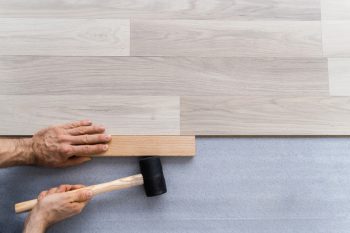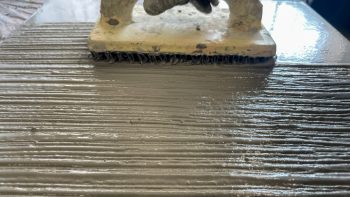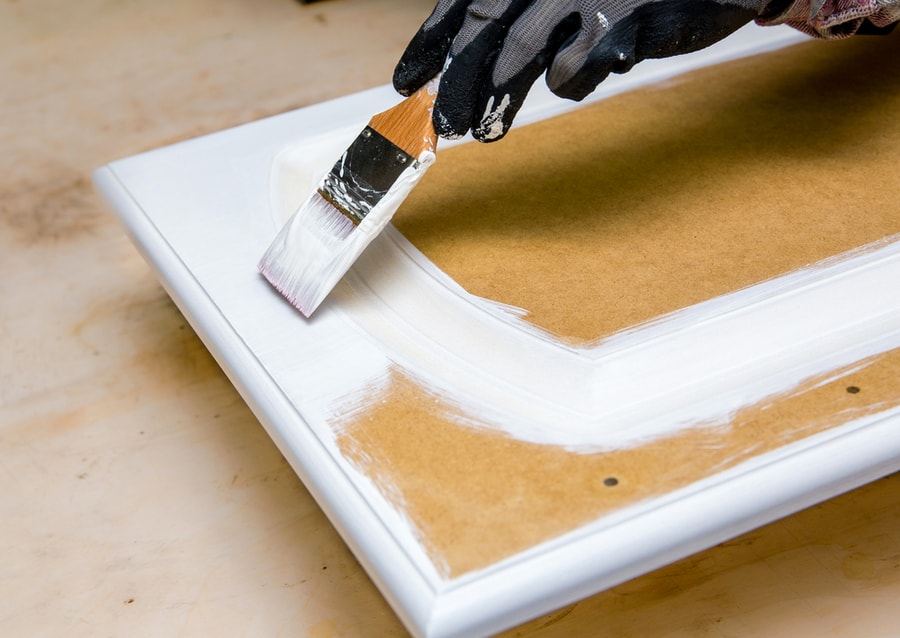
Laminate doors are the most prevalent alternative to hardwood doors. They are made of strong, durable composite material, pressed and shaped to look like a hardwood door. Nowadays, laminate doors are the most preferred option for interiors.
Their diversity in design, cost-friendliness, durability, and strength makes them the most popular choice in the market. You can find laminate doors in a wide range of colors.
But, if you want the color of your already-installed laminate doors changed without replacing them, you can paint them. Painting your laminate doors is easy and a fun activity.
Here’s how you can give your laminate doors a brand-new look with a few simple steps.
You can successfully paint your laminate doors by following a few easy steps. Preparing the surface and using the correct items is the key to making the painted door look professionally done.
Following is a list of things you will need:
- 80 or 100-grit sandpaper or electric sand.
- House tools like screwdrivers, nails, etc.
- Vacuum cleaner for cleaning off debris.
- Roller brush or paint brush and roller tray.
- Drop cloth or newspaper.
- Paint primer or trisodium phosphate.
- Good quality enamel paint.
- Personal safety equipment.
The paint, even if dried, will take a few weeks to achieve maximum hardness. Therefore, you will need to be cautious for the first couple of weeks. Wear a mask and gloves for protection.
Make sure you paint your door in a well-ventilated area to avoid the smell of the paint settling in your house.
This article is a complete guide on how to paint laminate doors. We have covered every detail step-by-step, from the tools and equipment you require to the last finish. You will also find many helpful tips about maintaining your laminate doors.
9 Steps to Painting Your Laminate Door
There are different types of laminate doors, and this method applies to all of them. Laminate doors are easy to paint, and there isn’t any complexity involved.
You can do this job yourself. So, grab your tools, and let’s get started.
1. Preparing Your Door for the Paint Job
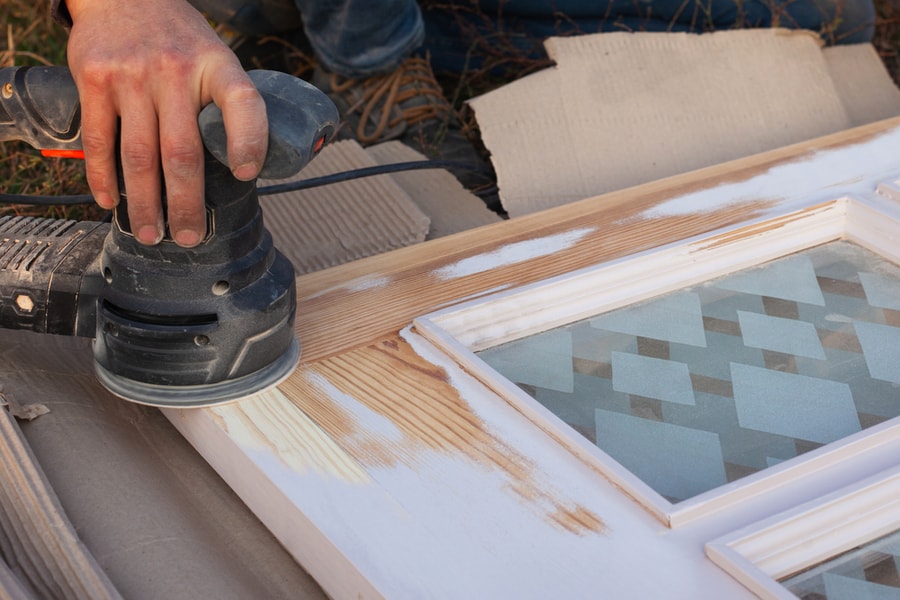
Planning and preparations before painting your laminate door are crucial. You have to ensure beforehand whether or not painting your laminate door is the right choice for your space because there are cases where the door has been worn-out so much that you can not conceal the damage simply by painting.
People often skip this step, thinking they do not need to repair or fix any prior damage and can give their door an ultimate make-over by painting over the impairments. But it ends up looking bad.
Therefore, you must check, in advance, what the condition of your door is. If you notice cracks, laminate peel, or any other deformation to your door, you must fix it before you paint.
Cracks and other deformations may affect the adhesion of paint. If the laminate door you want to paint has been painted on previously, you will need to remove the previous layer of paint.
Because it might interfere with the new layer and cause the new coating to chip off, you can use sandpaper and a scrapping tool to remove the previous paint.
If your door is in good condition, you may skip and move to the next step. It is still safe to examine the door beforehand. Once you are sure your door is ready for the paint job, move on to the next step.
2. Removing the Fixtures
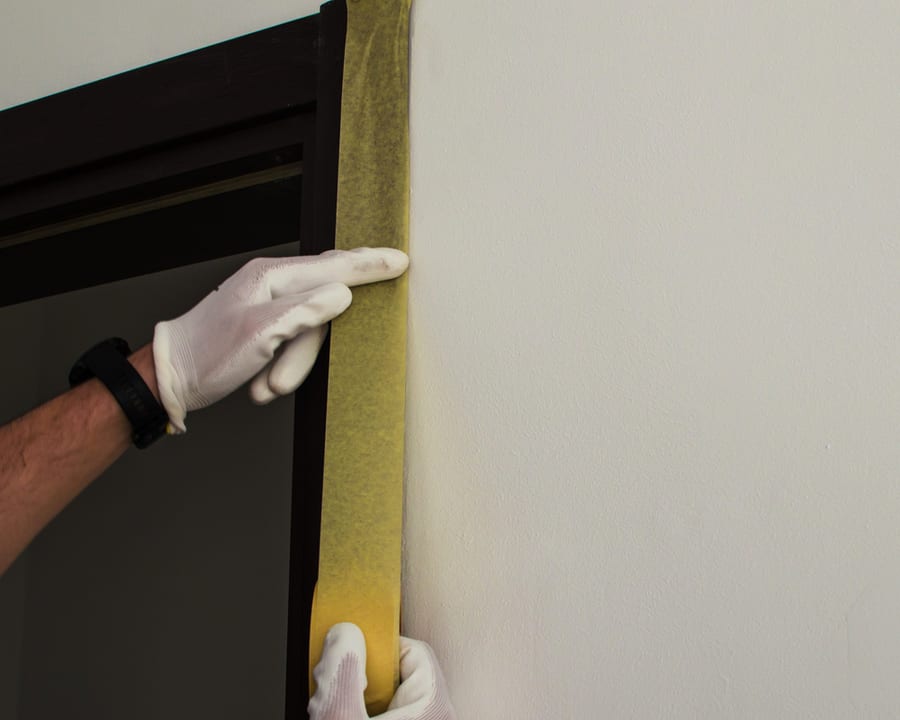
This step is almost like a continuation of the previous step. It is when you remove the doorknobs, door handles, bolt, hanging accessory, or any ornament attached to the door to avoid painting over them.
Even if you wish to replace the fixtures with new ones, it’s recommended that you still remove them. It makes the sanding and painting process easy. Also, your door will have full coverage done, and you will not see any unpainted areas.
It is optional to remove the door. You may leave the laminate door connected to the wall when you paint, but if you are afraid of paint dripping and leaving drop lines near the bottom, you may unhinge the door and lay it on a flat surface (a big crafting table or floor).
If you are removing your door, make sure you lay drop cloth or newspaper because the process will get a little messy, and you wouldn’t want your work surface getting dirty.
You will need to lay drop cloth even if you do not remove the door. The drop cloth will catch any excess paint dripping.
3. Clean the Door
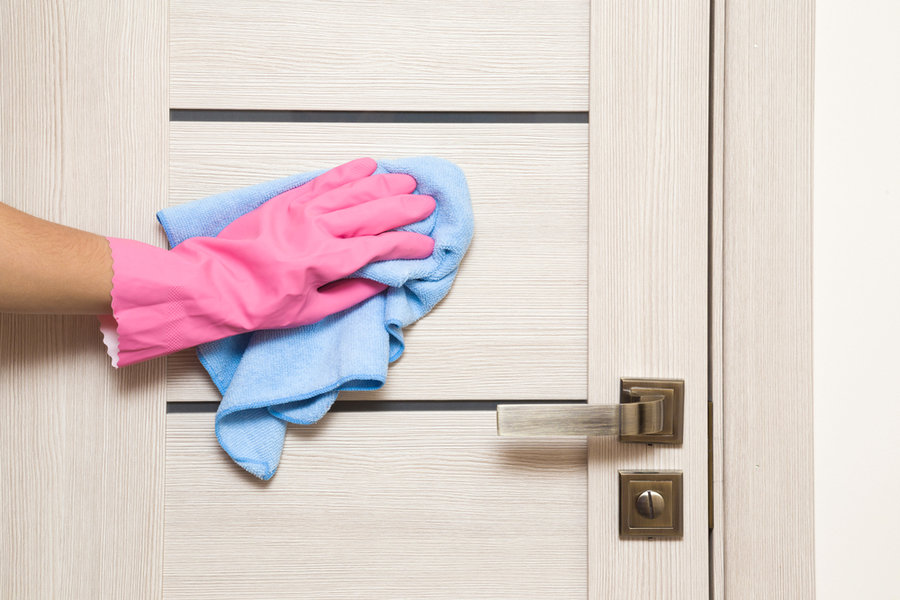
Cleaning the door will remove any grease or sludge stuck to the door. Removing and giving your door a gentle wash is important because the grease obstructs the sanding process.
Also, a layer of grease between the paint and the door might prevent the paint from sticking properly. You do not need any heavy-duty cleaners for this step. A mixture of soap and water will suffice.
It is best to use non-toxic cleaning solutions. Scrub away any grime or dust and let the door dry.
4. Sanding the Surface
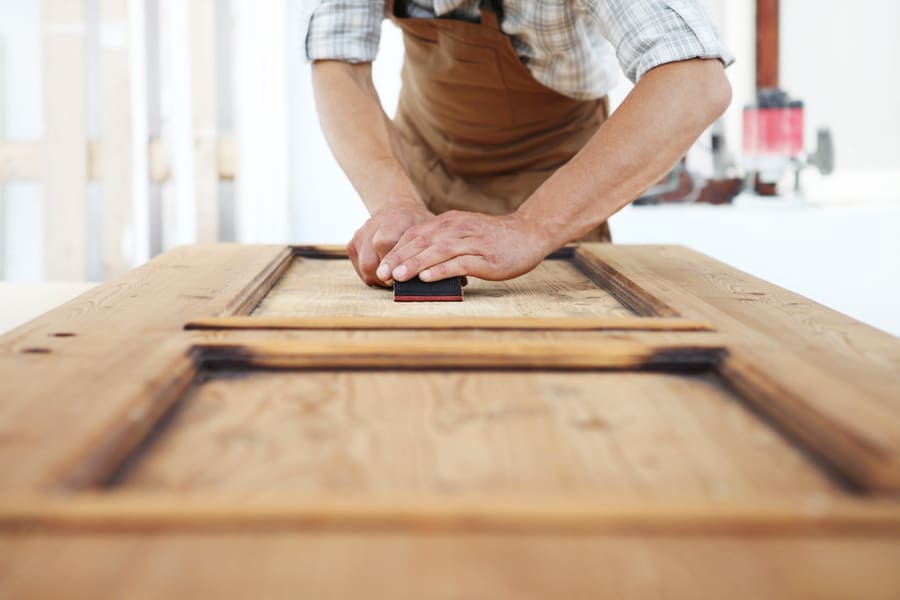
Sanding is another crucial step in giving your door surface a smooth and neat appeal. This is what sanding your door does.
It creates tiny grooves for the primer and the paint to stick, which ultimately helps your door finish to last longer and look more pleasant.
80-grit or 100-grit sandpaper is common for paint jobs and does a good job, but you can also use 150-grit sandpaper for a more smooth finish. You may sand down the door by hand or use an electric sander to save time.
5. Cleaning the Debris
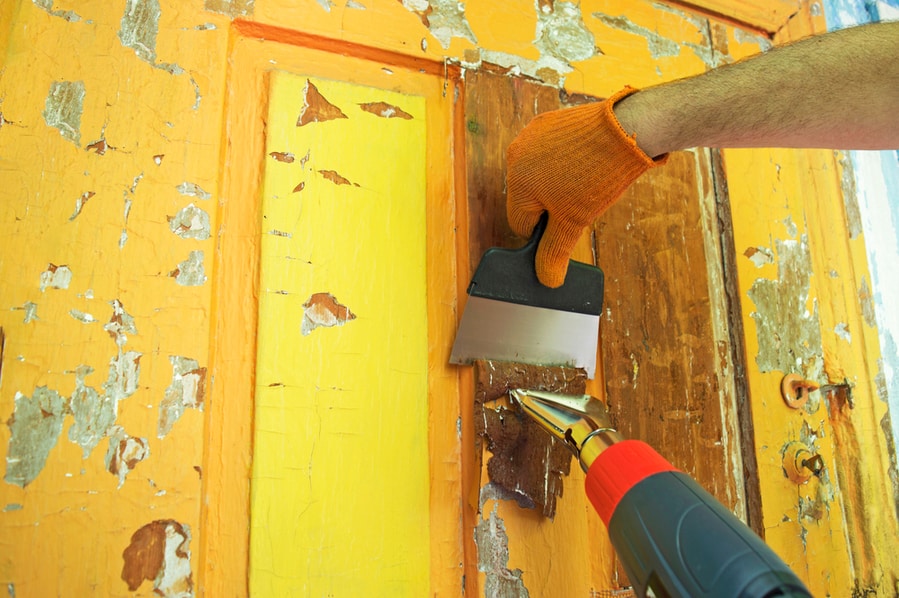
Sanding the door will create a lot of laminate dirt, some of which will stay stuck in the grooves unless you clean them. Therefore, grab your vacuum and clean the debris.
If you do not clean the dirt and dust left by sanding, these tiny particles will stay on the surface and create a coarse surface finish when you paint over them. Vacuuming the debris leaves a clean canvas for you to paint on.
6. Apply Primer
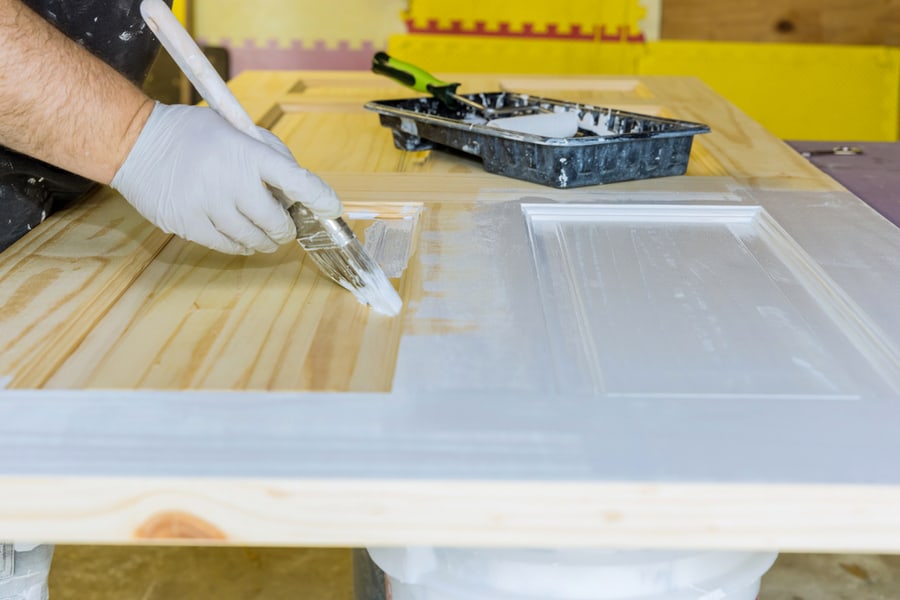
Primer helps the paint adhere better to the surface. There are many paint primers that you will find in the market, and choosing the right one may seem challenging.
You may consult the storekeeper of the store you are buying from. Pick a good quality primer with adhesion-promoting properties.
A good primer will give your surface an appropriate base to work on and will allow the paint job to stick effectively to the surface.
You may use a brush or a high-density foam roller to apply the primer. This step is easy and fun to do.
All you need to do is evenly cover all of your laminate door’s surface with the primer.
You may also use a spray-on primer which is easier to use. Spray all of the door’s surfaces and let them dry. It takes about 6 hours for one layer of primer to dry.
7. Sand the Primed Surface
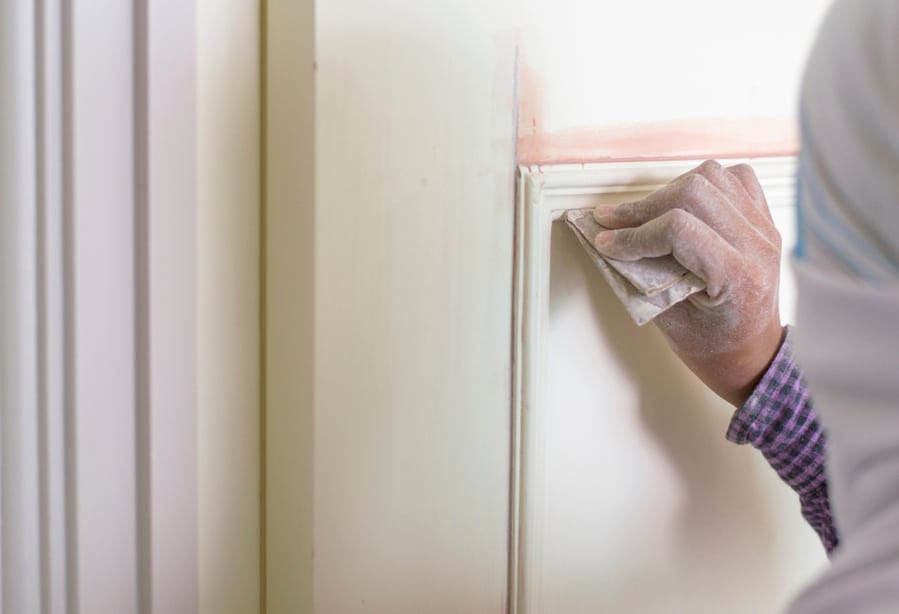
After the primer has dried, lightly sand the door’s surface again. This, again, creates tiny groves to help the paint stick better. For sanding a primed surface, use fine sandpaper.
You may use the sandpapers you used previously. But, you must not heavily sand the surface because it will remove the primer from the surface.
8. Apply Paint

After all the above steps have been correctly done, it is time for you to paint! You must choose good quality paint for your surface that lasts long and does not crack easily.
Use a good quality paintbrush or a roller for this job. Apply an even coat on the door’s surface and leave it to dry.
It will take almost 6-8 hours to dry. Once the first coat of paint dries, apply another layer following the same lines.
Make sure there is no excess paint dripping which will later leave drop lines. Typically, two layers of paint give a decent finish.
You may repeat the process of applying paint and drying till you are pleased with the paint coverage and finish.
Laminate doors usually have a glossy surface finish. Matte finish is not a popular choice because the greasy fingerprints eventually turn up. But if you love a matte finish, go for it. For the grease stains, you can just wipe them clean.
9. Let It Dry and Marvel at Your Work

Once you have applied the required paint layers, you need to let them dry. It takes a few weeks for all the layers of paint to harden fully.
So, you will need to leave your door undisturbed for a few weeks before reinstalling. If you reattach the door earlier, you must be careful around it. Do not apply any pressure to the door, which may ruin the paintwork.
When the paint completely dries, all left is to be proud of yourself for doing an excellent job and enjoy the makeover you gave your doors.
Safety Precautions
- The fumes from the primer and the paint can be toxic. Therefore, make sure your workspace is well-ventilated. Open the doors and windows while the primer and the paint job dry.
- Wear a mask while sanding the door to avoid inhaling dust particles.
- If you are using an electric sander, wear safety goggles to prevent debris from entering your eyes.
- The paint or the primer may contain toxins. Wear safety gloves to prevent the chemicals from touching your skin.
- Good quality tools are just as necessary as good quality products. High-quality tools give better results. So, invest in tools as well.
Conclusion
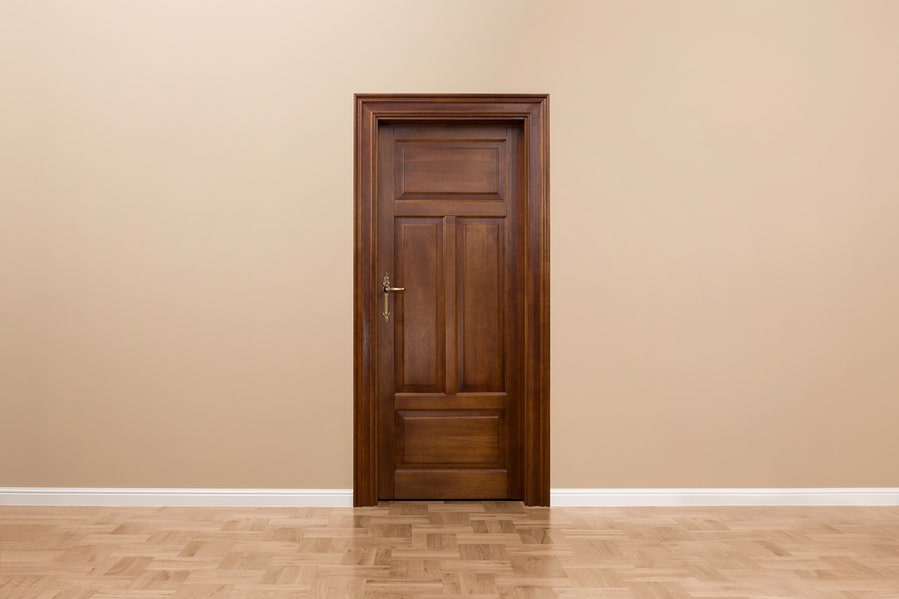
Painting your laminate door is a simple task. All you need is the correct products and tools, and you can give your interiors a nice renovation by painting the doors.
There are a few precautionary measures you must take to avoid any accidents. So, be careful while you are at it. Follow all the steps correctly to give your doors a brand-new appearance.
Frequently Asked Questions
What Kind of Paints Stick to Laminate?
We highly recommend latex paints for laminate doors. The reason is that they are highly durable and offer a smooth finish.
- Choose ProClassic interior acrylic latex enamel for lighter colors.
- Go for any surface latex enamel base to get deeper hues.
Can I Paint Directly Onto the Laminate?
Short answer, yes, you can. It is also quite simple to do so. You can even laminate without sanding and save up time and extra work.



